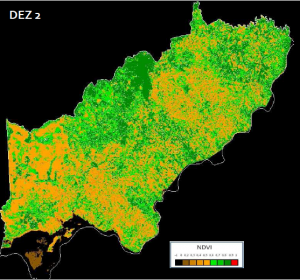
Deviations in remote sensing-based vegetation indices such as the Normalized Difference Vegetation Index (NDVI) shown above (Itapúa, Paraguay, December 2008) can be used to forecast crop productivity.
The bottom line in production agriculture is crop yield. Improving crop yield is the subject of continual study as researchers produce new plant varieties and agrochemicals and seek out the best management practices. Yet, producers are often at the mercy of natural forces, which they cannot control, especially changes in rainfall from season to season and year to year.
Production or yield risk comes from the unpredictable nature of natural factors such as weather or the performance of crops under the pressure of diseases and pests or other unforeseen factors. Together, all these risks can have a significant affect on the profitability and long-term sustainability of the farm enterprise. EnsoAg developed methodologies combining historical and real time weather records, crop statistics, crop yield modeling, and remote sensing to provide the agricultural industry with an improved understanding of crop yield risk.
Past yield records can be studied alongside historical weather information to help understanding the effects of climate variability on crop yield. We also developed applications based on crop models, which take into account climate forecasts, and can be used for evaluating alternative management practices, such as planting dates, crops, and varieties. Agricultural producers can study the future yield potential of a selected location under different climate scenarios and management practices with the click of a mouse. These applications can also be used to evaluate crop yield risk under a changing climate.
